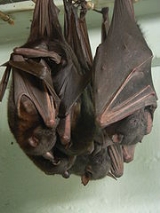
Little Red Flying-fox
Encyclopedia
The Little Red Flying Fox (Pteropus scapulatus) is a species of megabat
native to northern and eastern Australia
. With a weight of 300 – it is large fruit bat, but the smallest Flying Fox in mainland Australia (the other being the Black, Spectacled and Grey-headed Flying-fox
es). It has the widest range of all the species, going much further inland than the larger fruit bats. Its diet primarily consists of nectar and pollen of Eucalypt
blossoms, the pollination
of which it is largely responsible. The Little Red Flying Fox is nomadic, and can be found in large groups of up to a million individuals. This species births 6 months later than the other mainland flying-fox species, giving birth in April - May .
Negative public perception of the species has intensified with the discovery of three recently emerged zoonotic viruses that are potentially fatal to humans: Hendra virus, Australian bat lyssavirus
and Menangle virus.
Megabat
Megabats constitute the suborder Megachiroptera, family Pteropodidae of the order Chiroptera . They are also called fruit bats, old world fruit bats, or flying foxes.-Description:...
native to northern and eastern Australia
Australia
Australia , officially the Commonwealth of Australia, is a country in the Southern Hemisphere comprising the mainland of the Australian continent, the island of Tasmania, and numerous smaller islands in the Indian and Pacific Oceans. It is the world's sixth-largest country by total area...
. With a weight of 300 – it is large fruit bat, but the smallest Flying Fox in mainland Australia (the other being the Black, Spectacled and Grey-headed Flying-fox
Grey-headed Flying Fox
The Grey-headed Flying-Fox, Pteropus poliocephalus, is a megabat native to Australia.Members of the genus Pteropus include the largest bats in the world. The Pteropus genus has currently about 57 recognised species....
es). It has the widest range of all the species, going much further inland than the larger fruit bats. Its diet primarily consists of nectar and pollen of Eucalypt
Eucalypt
Eucalypts are woody plants belonging to three closely related genera:Eucalyptus, Corymbia and Angophora.In 1995 new evidence, largely genetic, indicated that some prominent Eucalyptus species were actually more closely related to Angophora than to the other eucalypts; they were split off into the...
blossoms, the pollination
Pollination
Pollination is the process by which pollen is transferred in plants, thereby enabling fertilisation and sexual reproduction. Pollen grains transport the male gametes to where the female gamete are contained within the carpel; in gymnosperms the pollen is directly applied to the ovule itself...
of which it is largely responsible. The Little Red Flying Fox is nomadic, and can be found in large groups of up to a million individuals. This species births 6 months later than the other mainland flying-fox species, giving birth in April - May .
Public Perception
This species of flying-foxes hangs in a different way to other mainland species. The larger species tend to hang an arm length apart, however the Little Reds tend to clump together so that the bats may hang in groups of 20 or more animals on an individual branch. This is shown on a small scale in the image on this page. For this reason the animals are associated with significant canopy and branch damage in camps where they reside. They also tend to appear in very large numbers (20,000 or more) and can cause the 'foot print' of a camp expand rapidly for the several weeks or months they remain at a site. The large numbers of animals and damage to a camp site mean they are not very popular animals.Negative public perception of the species has intensified with the discovery of three recently emerged zoonotic viruses that are potentially fatal to humans: Hendra virus, Australian bat lyssavirus
Australian bat lyssavirus
Australian bat lyssavirus is a zoonotic virus closely related to rabies virus. It was first identified in a 5-month old juvenile Black Flying Fox collected near Ballina in northern New South Wales, Australia in 1996 during a national surveillance program for the recently identified Hendra virus...
and Menangle virus.

